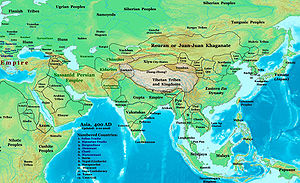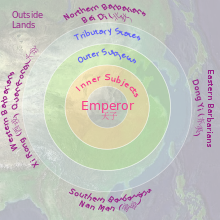- Xionites
-
Xionites, Chionites, Chionitae, (Middle Persian: Xiyon, Avestan: Xiiaona, Sogdian:xwn), Hunni (Pahlavi:Huna, Yun (Chinese: 狁; pinyin: Yǔn) or Xūn (獯), were a nomadic tribe prominent in Transoxania and Bactria.[1]
The Xionites arrived in the mid-4th century with the wave of immigration from Central Asia into Iran in late antiquity. They had been influenced by the Kushan and Bactrian cultures, and became a threat on the northeastern frontier of the Sassanid Empire.[1][2]
Contents
Origins
It is difficult to determine the ethnic composition of the Xionites.[1] In addition, there is no evidence that the Xionites were different from the Hephthalites. In other words, the Hepthalites may have been a prominent tribe or clan of the Xionites.[3]
In 1932 Sir Harold Walter Bailey wrote:[4]
“ Xyon. This name is familiar in Pahlavi and Avestan texts. It would appear to be a name of an enemy of the Iranian people in Avestan times, transferred later to the Huns owing to similarity of sound, as Tur was adapted to Turk in Pahlavi. In the present passage (a passage from the Pahlavi book of Bahman Yasht) three divisions of this people seem to be recognized, the Xyon with the Turks, the Karmir (Red) Xyon, and the White Xyon. ” In 1944 Carlile Aylmer Macartney wrote:[5]
“ We must consider briefly a third nation playing a role in our sources: the Kermichiones. Who were these people? They cannot have been the Turks-Toue-Kioue, since their embassy reached Constantinople while the Avars were still negotiating with Rome for settlement inside the frontier-probably, therefore, as early as A.D. 558, whereas the true Turks appeared there first in 568; further, their ruler's name was `Aσκήλτ or Scultor, while the Khagan of the Turks at that time was Silzabul, Dizabul, or Istämi. Neither can they have been the Juan Juan, as Marquart suggests; nor the Epthalites, who were well known to the Byzantines and would not have been described in this way. Moreover, the Epthalites were known as White Huns, and Mr. Bailey has pointed out that the word Karmir xyon, meaning Red Chyon, occurs in a Pahlavi text in juxtaposition with SpEt xyon, White Chyon. The name Chyon, originally that of some other race, was "transferred later to the Huns owing to the similarity of sound". The nation can hardly be other than that which appears in the fourth century, under the name of Chionits, in the steppes on the north-west frontier of Persia. These Chionites were probably a branch of the Huns, the other branch of which afterwards appeared in Europe, the latter appear to have attacked and conquered by the Alans, then living between the Urals and the Volga about A.D.360, while the first mention of the Chionites is dated A.D.356. In the fifth century the name is replaced by that of the Kushan or of the Kidarite Huns, who are clearly identical with the Kushan. ” A more recent specialist, Richard Nelson Frye[6] wrote in 1991:
“ Just as later nomadic empires were confederations of many peoples, we may tentatively propose that the ruling groups of these invaders were, or at least included, Turkic-speaking tribesman from the east and north, although most probably the bulk of the people in the confederation of Chionites and then Hephtalites spoke an Iranian language (...) This was the last time in the history of Central Asia that Iranian-speaking nomads played any role; hereafter all nomads would speak Turkic languages. ” In 1992 Wolfgang Felix [1] considered the Xionites a tribe of probable Iranian origin that was prominent in Bactria and Transoxania in late antiquity.
According to A.S. Shahbazi (2005)[2], the Xionites were a "Hunnic" people who by the early fourth century had mixed with north Iranian elements in Transoxiana, adopted the Kushan-Bactrian language, and threatened Persia.
History
Early history
In the earliest periods, the Xionites (Xiōng (匈) were more of a concern to the Chinese than to the Persians. They were probably identical with the Húnyí (混夷) or "Mixed-Barbarians" that Chinese records mention roaming in the west, and the Xirong (Chinese: 匈 / 西戎; pinyin: Xiōng / Xīróng) or "Western Barbarians" of Chinese history. They dominated the smaller Donghu nations in the East Asian steppes beyond the Tianshan, who were known as the "Xiong's Serfs" or Xiongnu, until the Xiong's hold over them was broken by the Chinese by the end of the Sino-Xiongnu War.
They produced the ruling Hū (呼) clan after whom Hūsìmì (呼似密) (Khwarezm) was named. According to Sima Qian, these rulers were descendants of Chunwei (淳維), possibly a son of Jie, the final ruler of the Xia Dynasty.
Conquest of Bactria
See also: KidaritesXionite campaigns are better documented in connection with the history of Central Asia, particularly during the second half of the 4th century AD until the mid 5th century AD.
They organised themselves into Northern "Black" (beyond the Jaxartes), Kidarites or Southern "Red" (in Hindu Kush south of the Oxus), Eastern "Blue" (in Tianshan), and Western Hephthalites or "White" (around Khiva) hordes. Artefacts found from the area they inhabited dating from their period indicate their totem animal seems to have been the (rein)deer. An inscription on the walls of the royal palace in Persepolis about Darius's empire calls them Hunae. It appears that a combination of both the Battle of Ikh Bayan and Ban Chao's efforts are responsible for their first appearance in the West. The Armenian historian Moses of Khorene (5th c.), in his "History of Armenia," introduces the Hunni near the Sarmatians and goes on to describe how they captured the city of Balkh (Armenian "Kush") sometime between 194 and 214 which is why the Greeks called that city Hunuk.[7]
According to the Armenian sources their capital was at Balkh (Armenian: Kush). Their most famous rulers were called the Kidarites.
At the end of the 4th century AD, a new wave of Hunnic tribes (Alchon) invaded Bactria, pushing the Kidarites into Gandhara.[8]
Alchon
See also: Hephthalite and Huna peopleAlchon or Alχon (Uarkhon) became the new name of the Xionites in 460 when Khingila I united the Uar with the Xionites under his Hephthalite ruling élite.
At the end of the 5th century the Alchon invaded northern India where they became known as the Huna. In India the Alchon were not distinguished from their immediate Hephthalite predecessors and both are known as Sveta-Hunas there. Perhaps complimenting this term, Procopius (527-565) wrote that they were white skinned, had an organized kingship, and that their life was not wild/nomadic but that they lived in cities.
Although the power of the Alchon in Bactria was shattered in the 560's by a combination of Sassanid and proto-Turkic forces, the last Hephthal king Narana/Narendra managed to maintain some kind of rule between 570 and 600 AD over the 'nspk' or 'napki' or 'nezak' tribes that remained after most of the Alchon had fled to the west, where they became known as the Avars.
The Alchon were called Varkhon or Varkunites (Ouar-Khonitai) by Menander Protector (538-582) literally referring to the Uar and Hunnoi. Around 630, Theophylact Simocatta wrote that the European "Avars" were initially composed of two nations, the Uar and the Hunnoi tribes. He wrote that: "...the Barsilt, the Unogurs and the Sabirs were struck with horror... and honoured the newcomers with brilliant gifts..."[9] when the Avars first arrived in their lands in 555AD.
Coinage
Alchon Huns refers to a tribe which minted coins in Bactria in the 5th & 6th centuries. The name Khigi on one of the coins and Narendra on another has led some scholars of the area to believe that the Hephthalite Khagans Khingila and Narana were of the AlChoNo tribe inscribed in Bactrian script on the coins in question. They imitated the earlier style of their Hephthalite predecessors, the Kidarite Hun successors to the Kushans. In particular the Alchon style imitates the coins of Kidarite Varhran I (syn. Kushan Varhran IV).[10]
Red Huns and White Huns
The name Xyon is found in Avestan and Pahlavi texts.[11] In the Avestan tradition (Yts. 9.30-31, 19.87) the Xiiaona were characterized as enemies of Vishtaspa, the patron of Zoroaster.[1] In the later Pahlavi tradition, the Red Huns (Karmir Xyon) and White Huns (Spet Xyon) are mentioned.[1] The Red Huns of the Pahlavi tradition (7th C.)[12] have been identified by Harold Walter Bailey as the Kermichiones or Ermechiones.[1] According to Bailey [13] the Hara Huna of Indian sources are to be identified with the Karmir Xyon of the Avesta. Similarly he identifies the Sveta Huna of Indian sources with the Spet Xyon of the Avesta. Bailey argues that the name Xyon was transferred to the Huna owing to similarity of sound, as Tur was adapted to Turk in Pahlavi tradition.[4] It is necessary therefore to differentiate between "Kermichiones/Ermechiones", "Red Huns" or "Hara Huna", identified with the Kidarite dynasty, and "Xionites" "White Huns" or "Sveta Huna", identified with the Hephthalite dynasty.
Later, the Armenian Patriarch John (c.728) mentions an ancient town of Hunor's foundation (Hunoracerta) in the Utik region, suggesting a connection to the Utigur. The Armenian Agathangelus also mentions also that there are "Huns" living amongst the peoples of the Caucasus.
See also
- European Avars
- Huna people
- Uar
Notes
- ^ a b c d e f g Wolgang Felix in Encyclopædia Iranica, "Chionites". Online Edition 2006
- ^ a b A. Shapur Shahbazi in Encyclopædia Iranica, "Sasanian Dynasty", 2006)
- ^ Richard Nelson Frye; "Emperor Ardeshir and the cycle of history"
- ^ a b Harold Walter Bailey, Iranian Studies, Bulletin of the School of Oriental Studies, University of London. BSOAS, vol. 6, No. 4 (1932)
- ^ Carlile Aylmer Macartney, "On the Greek Sources for the History of the Turks in the Sixth Century" Bulletin of the School of Oriental and African Studies, University of London, Vol. 11, No. 2. (1944), pp. 266-275.
- ^ Richard Nelson Frye, "Pre-Islamic and early Islamic cultures in Central Asia" in "Turko-Persia in historical perspective", edited by Robert L. Canfield, Cambridge University Press, 1991. pg 49.
- ^ Chinese: [1]
- ^ Nomads of the Steppe
- ^ Theophilactus Simocatta, Historiae, -Ed. C. deBoor. Lipsiae, 1887, ps.251, 258
- ^ Alchon Huns
- ^ H. W. Bailey Iranian Studies
- ^ "Bahman Yasht" in Encyclopædia Iranica by W. Sundermann
- ^ (Bailey, 1954, pp.12-16; 1932, p. 945),
External links
Categories:- Eurasian nomads
- Pre-Islamic history of Afghanistan
- History of the Turkic people
- History of Uzbekistan
- Huns
Wikimedia Foundation. 2010.


